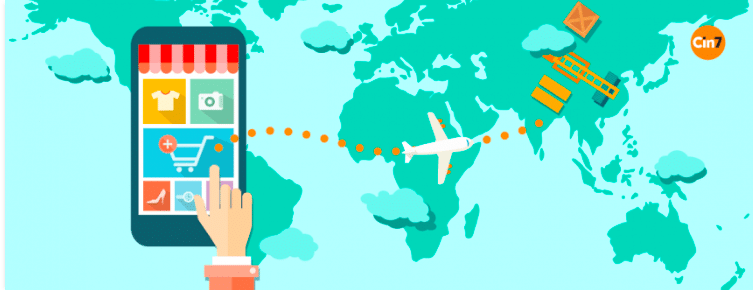The way SMEs may use eCommerce to cross international borders

Small and medium-sized companies (SMBs) have been the main driver of recent changes in India’s economic climate. By fostering entrepreneurship, innovation, and job opportunities, these companies greatly advance economic and social growth. Furthermore, these MSMEs and SMEs provide goods and services that support larger businesses and, as a result, make a substantial contribution to the industrial growth of the nation.
For SMBs today, e-commerce presents a disruptive potential. India is anticipated to surpass the US and China as the third-largest consumer market, with consumer expenditure rising from $1.5 trillion to about $6 trillion by 2030, according to a World Economic Forum analysis. This prognosis has been hastened by the epidemic. Businesses can connect with a far larger audience and meet their needs much faster through websites and applications.
E-commerce-related technologies have given SMBs the ability to transcend regional borders. In the upcoming years, incremental growth is anticipated from these markets as e-commerce expands beyond metropolitan India. Today, same-day or next-day deliveries, 10-minute deliveries, and just-in-time production have all become standard. SMEs and MSMEs are in a prime position to cross international borders. A significant portion of India’s $5 trillion economic ambition will be driven by the SMB clusters in its tier two and tier three markets. And logistics will be a key business enabler.
The sector of the logistics function
There is no doubt that the logistics industry is a crucial element in the movement of products, whether they are moved as completed items, raw materials, or through e-commerce. However, there are obstacles such as a lack of knowledge and regulations for cross-border trading.
The government has taken action to address this issue by establishing websites like IndiaXports by India SME forum, which provides information to companies searching for international business prospects. Some sectors, including aircraft, healthcare, and gems & jewelry, have complex supply chains that necessitate worldwide network skills, technological tools for visibility, and consistency in the supply chain if these companies are to compete in global marketplaces. Enterprises may incur large marketing expenses as a result of making an ill-informed decision, missing the correct market, and losing out on an opportunity.
Government programs to support SMBs
The government has launched programs in recent years to promote SMB growth and involvement in global commerce. A pivot for SMBs and the Indian start-up ecosystem, the government’s emphasis on technology adoption and the introduction of initiatives like “Make in India” and the “Atmanirbhar Bharat Abhiyaan” (Self Reliant India Campaign) aim to boost business and local manufacturing.
Additionally, several levels of government are aiming to establish districts as export centers, which is a crucial undertaking given that international commerce currently accounts for 45% of India’s GDP. The government decentralized export promotion in 2019, giving State governments more flexibility to participate actively in the choice-making process for marketing goods and services made at the local level.
A major goal of the move was to make it possible for SMBs to take advantage of global trade prospects, create an effective environment for innovation, lower transaction costs for exporters, and provide platforms for the e-commerce globalization of goods and services. All of these initiatives are eventually intended to shift the emphasis to district-led export growth for self-reliance and atmanirbhar Bharat.
While these programs will help small firms compete on a global scale, strict standards for product quality must be upheld. After all, several variables will work together to create the brand India in the international market.
To increase the nation’s competitiveness, the government has launched several measures. To guarantee that infrastructure investments are adequately coordinated, PM GatiShakti was introduced in 2021, with a more specific focus on creating a logistics infrastructure and setting up multimodal logistics facilities. The long-awaited National Logistics Policy (NLP), which seeks to simplify shipping and reduce costs throughout India, was unveiled by Prime Minister Narendra Modi on September 17.
The NLP, which falls under the purview of the PM GatiShakti Master Plan, intends to reduce India’s logistics costs from their present level of 13–14% of GDP* to below 10%. These policies are intended to work together to promote SMBs’ involvement in global markets in three key areas: connection, technology, and efficiency. NLP and GatiShakti claim to aid in boosting local products‘ competitiveness on the international market, enabling companies to expand their Indian exports and provide new job possibilities.
SMBs are at a fascinating crossroads where possibilities in the market and government policy may increase their success. With knowledge of cross-border compliance, digital tools for visibility throughout the supply chain, and an adaptable global network, the proper partner can assist in navigating these opportunities. All of these factors work together to make conducting business across borders as simple as doing business locally.
“The time is right for SMEs to concentrate on international markets through e-commerce and fast transition to direct exports,” The SMEs that are the backbone of the Indian economy were affected by the COVID-19 outbreak. Before the development of internet market platforms, SME exporters had to make a sizable financial and time commitment to join and market their companies internationally. To meet potential customers, get inquiries (leads) from importers, and secure orders, they needed to present at international trade shows and exhibits. After that, they had trouble with the logistics, payments, returns, and customer support. E-commerce now facilitates their smooth completion of this.
Consumers switched to online shopping for contactless payments and delivery as a result of the epidemic, which increased the use of e-commerce globally. The expansion of the internet, the rise in linked gadgets, and the increase in online searches by India’s 80% foreign-born population drove Indian SMEs to go online. Negative customer ratings for made-in-China items also helped made-in-India ethnic companies to gain traction with the Indian diaspora and other international customers.
Due to their reputation and reputation for providing high-quality products that match international standards at low rates, Indian SMEs were also encouraged by the US-China trade war to enter foreign markets. The government’s initiative, “Atmanirbhar Bharat,” to promote “Make in India” goods has stoked global demand for Indian goods.
Growing e-commerce
The e-commerce platforms provide a backdoor to exporting, allowing SMEs to reach clients globally who often do online searches for the goods they want to buy. E-commerce is simple to implement and grow in size for small businesses with no presence in the host nation marketplaces.
They lessen reliance on conventional foreign purchasers, whose purchasing methods are significantly less transparent as a result of their negotiating strategies. The SME export cycle is simple thanks to online marketplaces. The moment is right to concentrate on using e-commerce to explore international markets before fast switching to direct exporting.
Many Indian direct-to-consumer (D2C) firms use inbound marketing, lead generation, order booking, invoicing, payment receipting, sending finished items, and service support to expand their worldwide reach. They are seeing considerable demand across all product and service categories in foreign markets. To help SMEs get access to global markets, certain items from India are affordable and nevertheless fulfill international standards.
E-commerce has democratized global trade, allowing SME exports to take place anywhere in the world. The domestic market is no longer the exclusive target market for SMEs. A reliable platform for conducting business and engaging in transactions both domestically and abroad is provided by e-commerce. E-commerce enables SMEs to restructure, reduce costs, and even investigate expansion options to maximize resource usage and achieve better growth and profitability.
Since e-commerce provides technology breakthroughs and a larger consumer base through the internet, they may reach a wider market for advertising their goods and services. E-commerce has an impact on SMEs’ internationalization and growth. Despite generating billions of dollars annually, e-commerce has several problems that affect SMEs.
Physical stores still account for at least 90% of all retail sales in India, even though e-commerce sales are expanding more quickly than physical ones. The ability to “see, touch, and feel” an item is the primary advantage of physical storefronts over internet retailers, which is not always feasible.
Platforms for e-commerce: An analysis
Primarily speaking, conventional SME exporters will have a greater link and connection with their clients than e-commerce platforms. The commoditization of brands may result in cheaper operating expenses and revenues for e-commerce platforms, but they can still draw in more users and sales.
E-commerce is demonstrating its benefits. By serving as a middleman or facilitator between the two, it connects the buyers and vendors. Online shops can also handle the logistics and payments. Even small businesses that focus on services may compete on an equal footing with major service providers in fields like telemedicine, consultancy, psychotherapy, yoga, wellness, and others. The advantages include a broader audience, increased money, and fewer hassles.
Apart from companies like India Mart Alibaba and several other trade portals in the B2B markets, India is home to numerous well-established foreign- and Indian-origin e-commerce giants operating in the B2C markets. These companies include Amazon, Flipkart, Myntra, Shopclues, and others. E-commerce steps in to help numerous small SMEs who lack the understanding of foreign clients, their culture, the ability to market their enterprises overseas, and the resilience to endure losses owing to the dangers associated with payments and logistics.
Even SMEs with little resources might obtain early experience in global markets by setting up an online store for such expansion. The moment is right for the Indian government to change the direction of SME exports through e-commerce. To help SMEs and set them on a new development trajectory, our e-commerce policy framework must offer a level playing field.
The government has to encourage the SMEs with some important policy reforms to get more competitive in quality and pricing if it wants to speed up the e-commerce exports by Indian SMEs. For SMEs to choose the D2C path, the availability of financing and logistical assistance is equally important.
The ideal technique for a small firm to sell online in foreign markets is frequently a topic of discussion. Joining certain well-known e-commerce platforms might be the initial simple step for SMEs aspiring to global development before beginning an autonomous D2C presence for deeper involvement in the targeted markets.
In summary, SMEs require internet business facilitation and full-time government support. SME company owners would be better able to use e-commerce platforms to expand their customer base if they were educated on global value chains and quality compliance. In addition, SMEs without strong technology skills require defense against cybercrimes. To identify the goods and markets and comply with export regulations, states might establish Export Facilitation Cells (EFCs) with the help of the District Industries Centers (DICs).
Edited by Prakriti Arora




